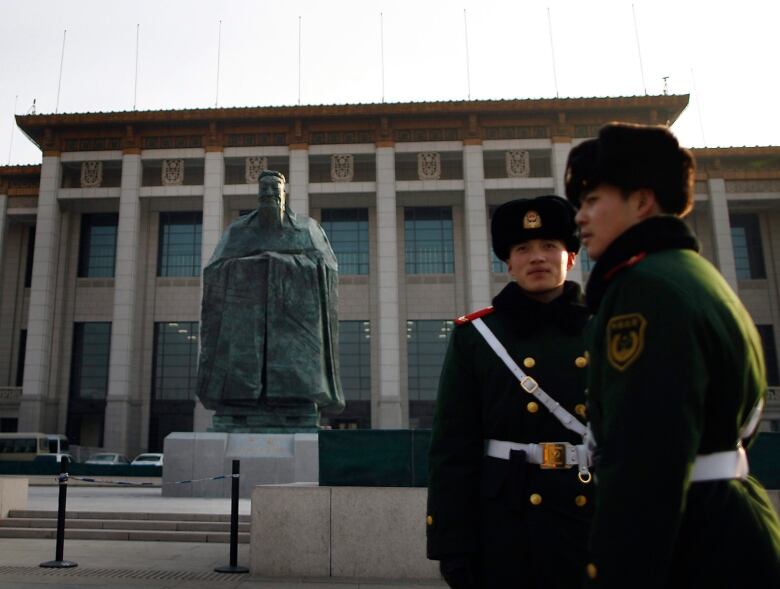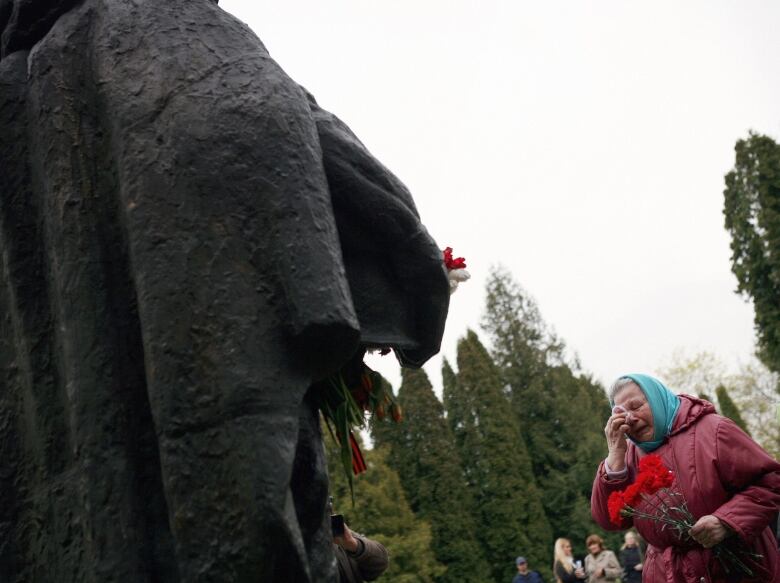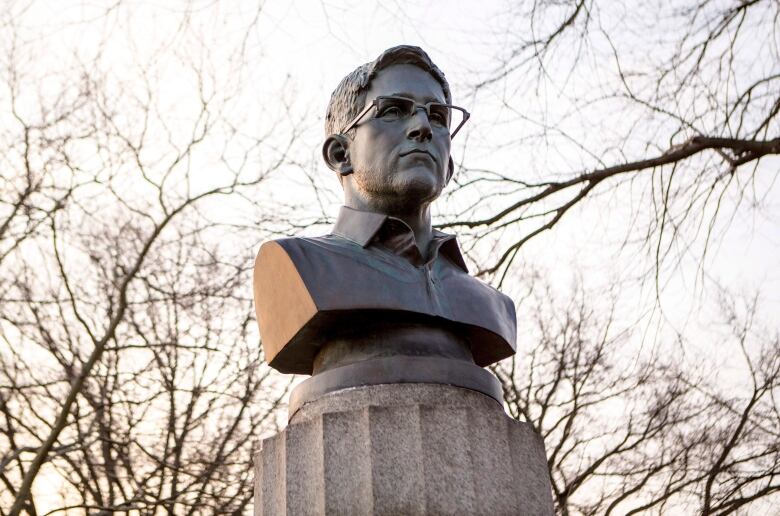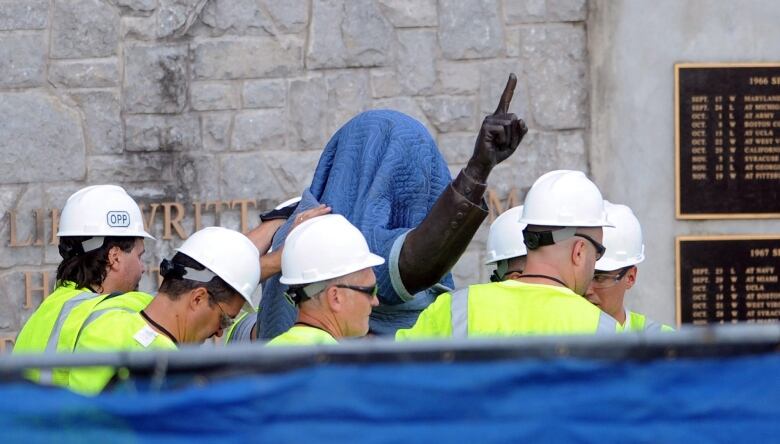The heated politics of public monuments
From Stalin to Saddam, some of the statues that have provoked high emotions so far this century
The City of New Orleans in 2015 voted to remove four prominent monuments of Confederate-era figures soon after a racialized mass murder in South Carolina.
Their removal has taken place in recent weeks, including a statue honouring the most prominent figure, Robert E. Lee.
Here are some 21st-century moments by no means a comprehensive list in which controversial monuments and statues were debated, vandalized, destroyed or moved from public viewing.
Wrestling with the Confederacy
A construction crew is shown below in New Orleans on May 11, 2017, removing the monument of Jefferson Davis, the Southern politician and colonel who supported slavery. The city's mayor and his supporters say the monuments are a reminder of a bitter legacy of racism in a city that is 60 per cent black, and that the monuments were erected decades after the Civil War. Protesters have blasted what they see as an erasing of history.Workers employed in taking them down have worn bulletproof vests, such is the heated nature of the project.

Reigniting decades-long dispute
Details of the sexual slavery some Korean women were forced to endure for the Japanese military during the Second World War are still being learned decades later. They have been a point of contention between Japan and South Korea as recently as January, when a so-called comfort-woman statue was placed in front of Japan's consulate in Busan, South Korea.
In this Jan. 11, 2017, photo, students gather near a comfort-woman statue during a rally in front of the Japanese embassy in Seoul. The statues led to Japan recalling diplomats and threatening economic retribution.

Gone but not forgotten
In Joseph Stalin's birthplace of Gori, Georgia, a six-metre high bronze statue loomed in the centre of the town for over half a century. In June 2010, local officials removed it so it could be replaced by a monument to victims of Georgia's 2008 war with Russia. The statue of Stalin was dismantled but sent to the local museum that focuses on the Soviet dictator's legacy. Despite the untold numbers Stalin killed, some Georgians still pay homage at the museum on his birthday, it is said, to recognize his local roots and his fight against fascism.

Bloody legacy
In Canada there have been recent controversies surrounding monuments and legacy as theypertainto Louis Riel and suffragette Nellie McClung, as well as prime ministers John A. Macdonald and Sir Wilfrid Laurier. Below, metaphorical blood in the form of red paint is shown in Halifax in 2016 at the Edward Cornwallis statue. Cornwallis founded Halifax and issued the so-called scalping proclamation, which offered bounties for the heads of Mi'kmaq persons.

Here and gone philosophy
Chinese paramilitary policemen standguard in the capital Bejing in front of a giant sculpture of Confucius on Jan. 12, 2011, just days after it was put on display in front of the Communist Party museum in Tiananmen Square. By April of that year, the 9.5-metre, 17-tonne statue was gone, without immediate party comment.
"Is it because he is not a Communist Party member?" an anonymous poster asked on a popular Chinese blog. Other online users celebrated the development, calling Confucius a slave owner whose imagery shouldn't be associated with modern China's politics.

'I'd put it back up'
In some cases, statues come down by force as a peoples' frustrations are unbottled in times of political turmoil or liberation. Below, a U.S. soldier watches on April 9, 2003, as a statue of Iraqi President Saddam Hussein falls in Firdos Square in Baghdad.
In July 2016,a former Iraqi weightlifter who took a 10-kg sledgehammer to the Saddam statue that fateful day told reporters he regretted his part in toppling the edifice because of the bloodshed and occupation that followed.
"I'd put it back up but I'm afraid I would be killed," Kadhem Sharif told BBC.

The Bronze Soldier of Tallinn
A Russian woman cries in front of the Second World World War Red Army soldier in Tallinn, Estonia, on 2007. The Bronze Soldier of Tallinn had just been relocated from the centre of the city's capital to a military cemetery. The decision caused rioting in a city where half the population of 400,000 is ethnic Russian.

Rhodes felled
Students cheer as the statue of British colonialist Cecil Rhodes was removed from the University of Cape Town on April 9, 2015. The statue inspired the #RhodesMustFall campaign directed at addressing examples of institutional racism, including symbols and monuments said to be reminders of oppressive white-minority rule. Meanwhile, at Britain's Oxford University it was decided in 2016 their statue of Rhodes would remain despite split opinion on campus, as donors threatened their own, pound-related protest if it were to be removed.

What they did was secret
On April 5, 2015, Fort Greene Park in Brooklyn, N.Y., contained a monument to prisoners of war from America's War of Independence. At daybreak on April 6, 2015, a 100-pound statue of Edward Snowden was revealed to be fused to that century-plus monument. The tribute to the controversial CIA whistleblower, who is still considered a fugitive of justice for leaking classified intelligence, was on public display for a matter of hours. The Snowden statue was eventually returned to the two artists who had been working on it for a year. They were fined but not criminally charged.

Sports not a sanctuary
Quite often, the "real world" intrudes into the playing field, with lawsuits, criminal matters and death affecting the world of sports. A statue for legendary Penn State football coach Joe Paterno was unveiled in 2001 but removed 11 years later, seen below, as it was alleged Paterno had helped conceal for years reports that his assistant coach Jerry Sandusky was sexually abusing children.
The matter is not fully put to rest. Paterno's supporters defend his plausible deniability and believe his reputation has been besmirched. Fans continue to place flowers at the statue's former location in College Park, Pa., and in recent months hundreds of former players and school boosters released a statement requesting the school return the statue to public prominence.

With files from The Associated Press and Reuters












_(720p).jpg)


 OFFICIAL HD MUSIC VIDEO.jpg)
.jpg)



























































































